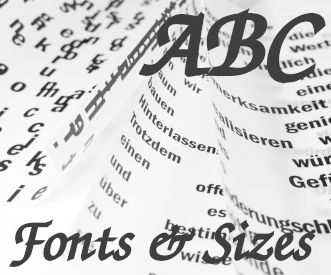Typography and Font selection
The variety of available fonts is overwhelming. Our educated experts with keen eyes on Corporate Identity and Corporate Design can assist you to chose the right font which, displays your business goals most. Many different fonts have a different appearance and thus create another impression on the visitor of your site.
Typography and font selection play a critical role in web design and can have a significant impact on the overall user experience of a website. When choosing a font for a web project, it's important to consider several key factors, especially in today's world where more and more people are accessing the web on a variety of devices, including smartphones and tablets.
One of the most important considerations is readability. The font you choose should be legible and easy to read, even on small screens and high-resolution displays, such as the iPhone's Retina display. A font that is too small or too intricate can be difficult to read, causing frustration for your visitors and detracting from the overall user experience.
Another important factor to consider is compatibility. Not all fonts are web-friendly, so it's important to choose a font that is supported across all browsers and devices. Web-safe fonts, such as Arial, Times New Roman, and Verdana, are a safe bet, as they are widely supported and have a proven track record for readability.
Responsive web design is also an important consideration when choosing a font. With the increasing number of people accessing the web on mobile devices, it's important to choose a font that is flexible and scalable, so it looks great on any screen size or resolution.
In addition to readability and compatibility, it's also important to consider the intended tone and style of the website. Different fonts convey different emotions and moods, so it's important to choose a font that accurately represents your brand and the tone of the content. For example, a more formal, traditional brand may want to use a serif font, while a more modern, casual brand may opt for a sans-serif font.
Finally, font pairing is crucial. When choosing a font, it's important to consider how it will pair with other elements on the page, such as headings, subheadings, and body text. A good font pairing can create a harmonious and cohesive design, while a bad pairing can detract from the overall aesthetic.
In conclusion, typography and font selection are critical elements in web design and can have a significant impact on the overall user experience of a website. When choosing a font for a web project, it's important to consider factors such as readability, compatibility, responsive web design, tone and style, and font pairing. By carefully considering these factors, you can ensure that the font you choose enhances the overall user experience of your website, especially on high-resolution displays like the iPhone's Retina display.

 EN
EN  DE
DE  FR
FR  ES
ES  IT
IT 